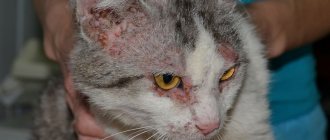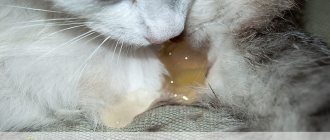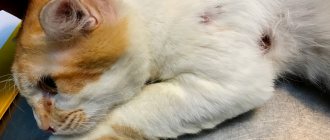17852Administration
Often, discharge from a cat on the outer labia is not considered normal and signals a problem with the animal’s health. Of course, you shouldn’t immediately panic and imagine a serious illness, because in some cases, discharge from the loop does not pose any danger.
But it won’t hurt to show your pet to a good veterinarian, since self-diagnosis is ineffective and is fraught with complications and consequences. Discharges can be very diverse :
- purulent;
- blood;
- watery;
- transparent;
- cloudy;
- white;
- gray;
- brown.
What is considered a physiological norm?
It is completely natural for a cat to have discharge during heat or estrus. The color of the discharge during this period is transparent, and the consistency is uniform without an unpleasant odor. The heat does not stop for several days, and the cat arches her back, exposes her hindquarters, and shows excessive playfulness and affection.
© shutterstock
Pregnancy and childbirth
Discharge during pregnancy may appear in a cat up to the third week. This is due to the fact that a mucus plug forms in the cervix, the excess of which flows out . This is usually clear or stringy mucus that is difficult to notice because it comes out along with urine. Until the 6th week, yellowish discharge is very rarely observed in small quantities - excess amniotic fluid.
And only a day or two before birth does the mucous plug come off (at 9 weeks). This is a small clot of yellow or greenish tint.
During contractions and pushing in a cat, the presence of brown and bloody discharge from the uterus is normal. For some time after childbirth, liquid greenish discharge appears, gradually becoming lighter, and then completely disappearing.
Scarlet blood at any stage of a cat’s pregnancy is always a sign of pathology and can be a signal of uterine rupture. The reason for the release of brown clots is placental abruption or fetal death . Green ones with an unpleasant odor indicate a bacterial infection, most likely due to the death of the kitten and the beginning of the decomposition process.
Treatment
- Only a qualified veterinarian should choose therapy to treat your pet after examination, ultrasound and carefully collected tests.
- If the placenta does not separate for a long time, injections of the hormone oxytocin are used. Only a specialist can correctly determine the dose of medication to protect your pet from unpleasant and painful consequences.
- For severe hemorrhage, vasoconstrictor and hemostatic medications are used.
- For infectious diseases, inflammatory and pathological processes, anti-inflammatory or antibacterial drugs are prescribed.
- For a speedy recovery of your pet, you should pay attention to the quality of its nutrition, a sufficient amount of vitamins and nutrients in it. Sometimes additional multivitamins or immunomodulators are prescribed.
- In particularly difficult cases, surgery is prescribed.
Recommended reading:
What to do if your dog's back legs fail?
Unhealthy uterine discharge
Inflammatory diseases of the uterus lead to the accumulation of pathological substances in its cavity - waste products of bacteria, ichor, particles of epithelium, etc. Blood or pus from the vaginal opening may be a symptom of urogenital tract cancer. A cat suffers from discharge due to the following dangerous diseases:
- vaginitis;
- pyometra;
- hematometers;
- hydrometers;
- endometritis.
Vaginitis
This is an inflammatory process in the vagina, which can be acute or chronic. Ulcers form on the surface of the mucous membrane, and the cat is bothered by discharge:
- cloudy or transparent;
- viscous yellow-white;
- mucous membranes are purulent.
Mild forms of the disease are treated with douching; in severe cases, systemic antibiotics are indicated.
© shutterstock
Pyometra
Life-threatening inflammation of the uterus, requiring urgent medical attention and surgical intervention. If a cat frequently licks itself, and brown wet spots remain everywhere on the bedding and carpets, then such symptoms should alert the owner. There are also other warning signs:
- tight or bloated belly;
- increased body temperature;
- lack of appetite, but strong thirst;
- frequent urination;
- decreased physical activity of the pet, lethargy.
In some cases, the cat's purulent discharge increases in quantity so quickly that the symptoms of the disease simply do not have time to appear. The walls of the uterus cannot withstand the load and rupture, and the contents spill into the abdominal cavity . Naturally, it is no longer possible to save the pet’s life.
Hematometer
The condition is characterized by the accumulation of blood in the uterine cavity, disrupting the functioning of the organ. Often blood cannot escape due to blockage or narrowing of the cervical canal, so the discharge from the cat's uterus is very scanty. The reason may be:
- congenital anomalies;
- muscle spasm of the cervical canal;
- surgical procedures performed incorrectly;
- miscarriage or abortion;
- pathological births (especially if they happen more than 1-2 times a year);
- uterine fibroids.
Blood is a rich nutrient medium for the proliferation of harmful microorganisms, which is why sooner or later inflammation of the uterus begins.
The cat has a fever and cramping pain appears. When helping an animal, clots must be scraped out of the uterine cavity and antibacterial therapy is prescribed. If hematometra is not diagnosed in time, purulent contents form in the uterus and the disease is complicated by pyometra. Fortunately, this disease is quite rare.
Endometritis
In a cat, discharge from the uterus may be a symptom of inflammation of the walls or mucous membranes of the organ. Acute endometritis occurs more often after childbirth due to delayed release of the placenta, infection of the vagina and cervix.
Mucopurulent discharge appears in cats from the genital slit 2–6 days after the birth of kittens.
Urination becomes more frequent, milk production decreases, and the temperature rises. The animal arches its back and meows pitifully due to pain in the uterus. In the absence of therapy, the pathology becomes chronic. The infection spreads to the muscular and outer layers of the uterus and penetrates the blood. As a result, the pet dies due to sepsis. Blockage of the cervical canal threatens the development of pyometra.
© shutterstock
Hydrometer
Fluid accumulates in the uterine cavity - gland secretion, mucus, transudate in quantities of up to 10 liters. If the excretory channel is open or partially blocked, then the cat experiences white or transparent discharge. Usually they are scanty, smearable or drop-shaped. The disease often develops against the background of chronic endometritis , as a result of which the uterine walls become thinner and stretched, adhesions and scars form. Without timely treatment, the cat dies.
Dangerous manifestations of discharge during the postpartum period in cats
In what cases is it necessary to visit a veterinarian?
Dangerous secretions
- Inability to provide her with a clean place to rest: in a dirty room there is a high probability of infection in the birth canal.
- Severe bleeding due to injury or tissue rupture during childbirth.
- Changes in the nature of the discharge: cloudy, black, grayish, excessively green and having an unpleasant, putrid or sour odor.
- Fever, high body temperature.
- Repeated vomiting.
- The bleeding does not stop for 10-15 minutes.
- Discharge of a thick consistency with a strong putrid odor is a good reason to urgently run to the doctor.
- Lack of appetite.
- Stressful, depressed state of the cat.
- Lack of desire to care for offspring.
When to see a doctor
An attentive and loving owner will immediately notice disturbances in the cat’s behavior and the presence of abnormal discharge after delivery.
Reasons to consult a doctor are:
- Putrid smell.
- Duration of discharge (more than 2 weeks).
- The appearance of white curdled flakes.
- Bleeding or blood clots.
- Feeling unwell with apparently normal discharge.
If any of these signs occur, you should immediately visit a doctor.
Clinical picture and diagnosis
As we have already said, the white color of the discharge often indicates the presence of purulent inflammation in the animal’s body. Since the latter in itself has a serious impact on the health of the animal, it is not surprising that the discharge is accompanied by obvious clinical signs:
- The cat constantly licks the genital area.
- The skin and mucous membranes of the external genitalia are inflamed and swollen.
- The animal may rub its butt against the floor or walls (due to severe itching). This is often confused with manifestations of helminthic infestations.
- As a rule, due to constant itching and pain in the genitals, the cat strains all the time, which is accompanied by frequent urination and defecation. In severe cases, defecation may be spontaneous, and the cat leaves puddles of urine and piles of feces throughout the house.
- Increased overall body temperature and increased thirst.
Accordingly, to make a diagnosis (taking into account various reasons) it will not be possible to do only with a visual examination. Complex complex diagnostics will be required:
- A complete, detailed blood and urine test will be required.
- It is necessary to sow secretions and scrapings from the vaginal walls onto nutrient media. This way you can find out exactly what you have to deal with this time.
- Microscopic and cytological examination of scrapings from the vaginal walls.
- Ultrasound examination and fluoroscopy of the pelvic organs and/or the entire abdominal cavity are strongly recommended.
- Vaginoscopy. If the result reveals any pathological neoplasms on the walls of the vagina, a biopsy is required.
- Serological studies of blood plasma aimed at identifying infectious diseases.
- A complete check of the condition of the urinary system is required.
Therapeutic techniques
Accordingly, treatment will also depend on the immediate underlying causes:
- If there is pyometra or tumors of any etiology in the uterus, complete surgical removal of the affected organ is recommended. The cat may no longer be able to give birth after this, but her health will be safe.
- In the presence of fistula passages, surgical intervention is also required.
- In almost all cases, broad-spectrum antibiotics are required. This is even used for fungal infections. Although antibiotics do not act directly on the causative agent of the infection, they effectively prevent the development of secondary bacterial infections.
- Accordingly, when fungal pathologies are detected, antifungal agents are prescribed. Please note that they are all very toxic and you will have to (as in the case of antibiotics) feed the kittens yourself. Mother's milk will become poisonous to them.
- For oncology that cannot be surgically removed, chemotherapy or radiotherapy is prescribed.
Let us repeat once again that white discharge from a cat that has given birth is always a reason for a visit to the veterinarian.
Main symptoms of urethritis
The first signs of the disease are frequent and difficult urination.
The animal sits on the tray for a long time, trying to urinate. A little later, severe pain when urinating is added to these symptoms. Blood can often be seen in the urine, and purulent discharge from the urethra appears. The cat loses his appetite and starts drinking a lot. In this case, very little urine is released from the bladder. There is a sharp increase in temperature, fever, and aggressiveness. With urethritis, cats cannot go to the toilet and sit in the litter box for a long time.
If treatment is not started in time, then complete intoxication of the body occurs: the animal begins to salivate profusely, a sharp unpleasant odor of acetone appears, emanating from the skin, saliva and urine, photophobia, and weakness.
This condition is called the acute form of urethritis, and it is often accompanied by complete or partial blockage of the urethra. There is also a chronic course of the disease, in which the cat urinates without difficulty, but often and painfully, and completely cured urethritis appears again and again. As soon as the animal becomes hypothermic or catches a cold, all the symptoms of the disease return.











